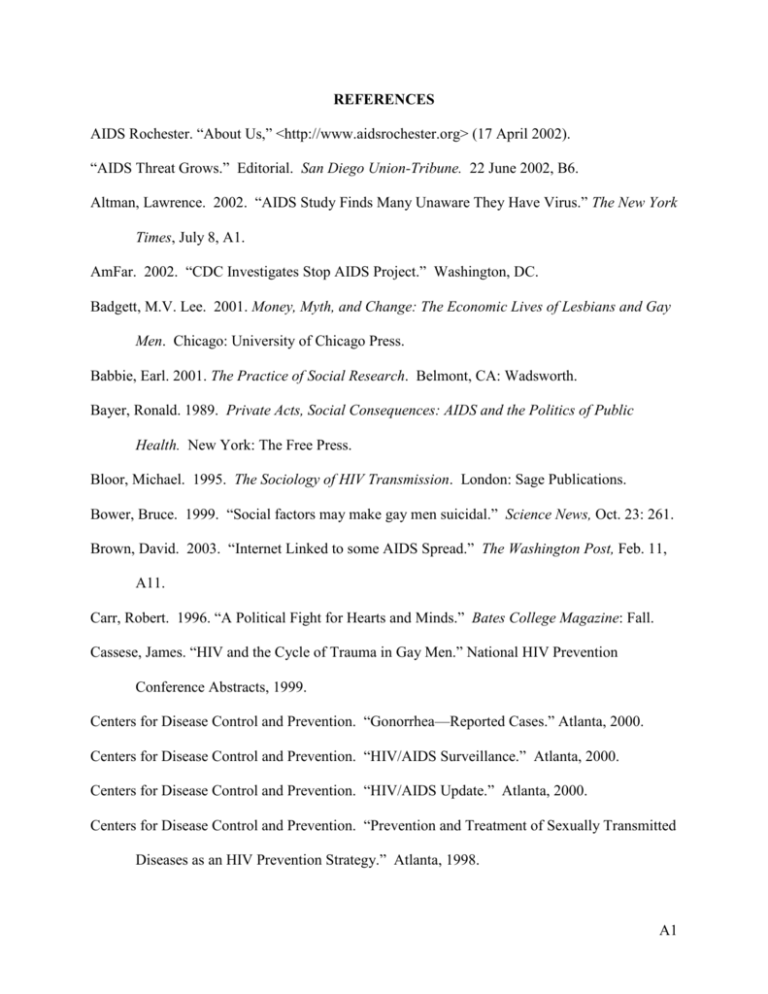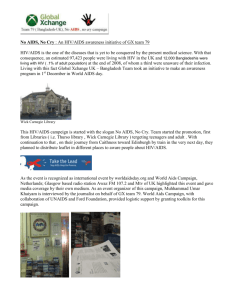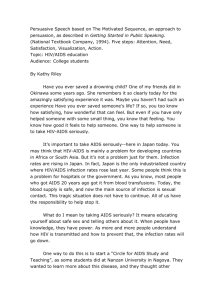
REFERENCES
AIDS Rochester. “About Us,” <http://www.aidsrochester.org> (17 April 2002).
“AIDS Threat Grows.” Editorial. San Diego Union-Tribune. 22 June 2002, B6.
Altman, Lawrence. 2002. “AIDS Study Finds Many Unaware They Have Virus.” The New York
Times, July 8, A1.
AmFar. 2002. “CDC Investigates Stop AIDS Project.” Washington, DC.
Badgett, M.V. Lee. 2001. Money, Myth, and Change: The Economic Lives of Lesbians and Gay
Men. Chicago: University of Chicago Press.
Babbie, Earl. 2001. The Practice of Social Research. Belmont, CA: Wadsworth.
Bayer, Ronald. 1989. Private Acts, Social Consequences: AIDS and the Politics of Public
Health. New York: The Free Press.
Bloor, Michael. 1995. The Sociology of HIV Transmission. London: Sage Publications.
Bower, Bruce. 1999. “Social factors may make gay men suicidal.” Science News, Oct. 23: 261.
Brown, David. 2003. “Internet Linked to some AIDS Spread.” The Washington Post, Feb. 11,
A11.
Carr, Robert. 1996. “A Political Fight for Hearts and Minds.” Bates College Magazine: Fall.
Cassese, James. “HIV and the Cycle of Trauma in Gay Men.” National HIV Prevention
Conference Abstracts, 1999.
Centers for Disease Control and Prevention. “Gonorrhea—Reported Cases.” Atlanta, 2000.
Centers for Disease Control and Prevention. “HIV/AIDS Surveillance.” Atlanta, 2000.
Centers for Disease Control and Prevention. “HIV/AIDS Update.” Atlanta, 2000.
Centers for Disease Control and Prevention. “Prevention and Treatment of Sexually Transmitted
Diseases as an HIV Prevention Strategy.” Atlanta, 1998.
A1
Coates, Thomas. 2002. “A wake-up call to the community.” San Francisco Chronicle, June 21.
Collins, C. “Dangerous Inhibitions: How America Is Letting AIDS Become An Epidemic of the
Young.” Center for AIDS Prevention Studies, UCSF, Jan 1997.
Community Health Network. “About CHN,” <http://www.communityhealthnet.org> (15 January
15, 2003).
Dynes, Wayne, editor. Encyclopedia of Homosexuality. 1990. New York: Garland Publishing.
Vol. 2
Eaklor, Vicki L. 2003. Gay American History course lecture. Alfred University, April 29.
Eaton, Leslie. 2002. “With Killings on the Rise, Upstate Cities Look for Answers.” The New
York Times, Dec. 30, B1.
Eisenberg, Marla. 2001. “Differences in sexual risk behaviors between college students with
same-sex and opposite sex experience: Results from a national survey.” Archives of
Sexual Behavior, 30(6): 575-590.
Erickson, Eric. 2001. “Explicit AIDS outreach questioned.” Washington Blade, Nov. 23.
Ernst F.A. and R.A. Francis. 1991. "Condemnation of Homosexuality in the Black Community:
A Gender-Specific Phenomenon?" Archives of Sexual Behavior, 20(6): 579-585.
Fergusson, D.M. 1999. “Is sexual orientation related to mental health problems and suicidality
in young people?” Archives of General Psychiatry, Oct.: 883-8
Florida, Richard and Gary Gates. 2001. “Technology and Tolerance: The Importance of
Diversity to High Technology Growth.” Washington: The Brookings Institution Center
on Urban and Metropolitan Policy.
“Gay Community on AIDS.” Editorial. San Francisco Chronicle. 21 June 2002, A23.
Gladwell, M. 1992. “’Safe-sex’ campaign said to be missing the mark.” The Washington Post,
A2
May 16, A1.
Gonsiorek, J. 1989. “Mental health issues of gay and lesbian adolescents.” Journal of
Adolescent Medicine, 9:114-122.
Goode, Erica. 2001. “With Fears Fading, More Gays Spurn Old Preventive Message.” The New
York Times, August 19, A1+.
Harris Interactive. 2002. “The Gay, Lesbian, Bisexual, and Transgender Population At-AGlance.”
Hayes, Robert. 1996. “What Puts People At Risk?: Young Gay Men.” UCSF Center for AIDS
Prevention Studies.
Heredia, Christopher. 2002. “HIV prevention messages failing to convince gays.” San
Francisco Chronicle, April 4, A2.
Jefferson, Elana Ashanti. 2002. “Sex 101 – College Students Increasingly Casual about
Bedfellows, Just as Casual about Condoms.” Denver Post, Oct. 30.
Kaiser Family Foundation. 2001. “Sizable Number of College Students Say Partners Have
Attempted to Dissuade Them From Condom Use.” Kaiser Daily Reproductive Health
Report, July 21.
Kellogg, Alex P. 2002. “’Safe Sex Fatigue’ Grows Among Gay Students.” The Chronicle of
Higher Education, January 18, A37-8.
Klitzman, Robert. C., Jason D. Greenberg, Lance M. Pollack, and Curtis Dolezal. 2001.
“MDMA (‘ecstasy’) use, and its association with high risk behavior, mental health, and
other factors among gay/bisexual men in New York City.” Drug and Alcohol
Dependence, March 3: 115-125.
Lippman, Laura. 1994. “A ‘Real World’ death: Pedro Zamora, 22, loses battle with AIDS.”
A3
The Baltimore Sun, November 12, D1.
McFarland, W. et al. 2001. “HIV Incidence Among Young Men Who Have Sex With Men—
Seven U.S. Cities, 1994-2000.” Morbidity and Mortality Weekly Report, June 1: 440444.
Middelthon, Anne-Lise. 2001. “Interpretations of condom use and nonuse among young
Norwegian gay men: a qualitative study.” Medical Anthropology Quarterly, March: 5883.
Mozes, Alan. 2002. “HIV Risk a Question of Place as Well as People.” Reuters Health, Oct. 2.
New York State Department of Health. “AIDS in New York State: 2001-2002 Ed.” Albany,
2002.
Nimmons, David. 2002. The Soul Beneath the Skin: The unseen hearts and habits of gay men.
New York: St. Martin’s Press.
Oncale, Renee and Bruce King. 2001. “Comparison of men’s and women’s attempts to dissuade
sexual partners from using condoms.” Archives of Sexual Behavior, August: 379-91.
Page-Shafer, Kimberly et al. 2002. “Men Who Practice Exclusively Oral Sex: Demographics,
Sexual Behaviors, and Perceived Risk of Oral Acquisition of HIV Infection.” UCSF
Center for AIDS Prevention Studies.
Painter, Kim. 1996. “AIDS Spreads Among Young Gays Despite Warnings.” USA Today, July
9, 1D.
Patton, Cindy. 1996. Fatal Advice: How Safe-Sex Education Went Wrong. Durham, NC: Duke
University Press.
Phillips, K.A. and J. Paul, et al. 1995. “Predictors of repeat HIV testing among gay and bisexual
men.” AIDS, July: 769-75.
A4
Reitman, David S. 2001. “Sexual Orientation.” eMedicine Online.
Rodriguez, Cindy. 2002. “Welfare plunged in ‘90s while poverty persisted.” Boston Globe,
June 5, A1+.
Rosenberg, Morris. “Society and the Adolescent Self-Image.” Princeton: Princeton University
Press, 1965.
Rotello, Gabriel. 1998. Sexual Ecology: AIDS and the Destiny of Gay Men. New York: Plume.
Rushing, William. 1995. The AIDS Epidemic: Social Dimensions of an Infectious Disease.
Boulder, CO: Westview Press.
Seage, G.R. and K.H. Mayer, et al. 1998. “The social context of drinking, drug use, and unsafe
sex in the Boston Young Men Study.” Journal of Acquired Immune Deficiency and
Human Retrovirology, April 1: 368-375.
Shehan, D.A. et al. 2003. “HIV/STD Risks in Young Men Who Have Sex With Men Who Do
Not Disclose Their Sexual Orientation—Six Cities, 1994-2000.” Morbidity and
Mortality Weekly Report, Feb 7: 81-86.
Strong Health. “AIDS Center,” <http://www.stronghealth.com> (17 April 2002).
Usborne, David. 2003. “Rise in AIDS Virus Linked to Gay Online Chat Rooms.” The
Independent (London), Feb. 13, 13.
US Census Bureau. “2000 Census of Population and Housing.” Washington, 2000.
UCSF Daybreak News. “San Francisco Gay Men Increasingly Having Unprotected Sex.” 30
June 1998.
“UCSF Researcher Finds Self-Acceptance of Gay Identity Decreases Sexual Risk Behavior.”
UCSF Center for AIDS Prevention Studies, 29 June 1998.
“UCSF Study Finds Community Building Reduces Young Gay Men’s HIV Risk Behavior.”
A5
UCSF Center for AIDS Prevention Studies, 8 July 2002.
“UCSF Study Finds Major Decline in HIV Prevalence Among Gay and Bisexual Men In Four
Cities.” UCSF Center for AIDS Prevention Studies, 18 Nov. 1998.
Vittinghoff, E. et al. 1999. “Per-contact risk of human immunodeficiency virus transmission
between male sex partners.” American Journal of Epidemiology, August: 306-311.
“What Puts People At Risk? African Americans.” UCSF Center for AIDS Prevention Studies,
1996.
Whitman-Walker Clinic. “Men Who Have Sex With Men (MSM) Survey Results 2001.”
Washington, 2002.
A6










